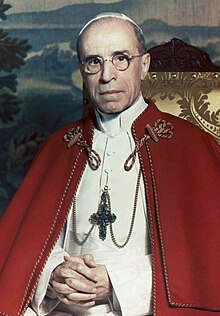
Back Paus Pius XII ACE Pous Pius XII Afrikaans Pius XII. ALS Pío XII AN بيوس الثاني عشر Arabic بيوس التناشر ARZ Piyu XII Aymara XII Piy Azerbaijani Pius XII. BAR Пій XII Byelorussian
Pius XII | |
|---|---|
| Bishop of Rome | |
 Pius XII c. 1951 | |
| Church | Catholic Church |
| Papacy began | 2 March 1939 |
| Papacy ended | 9 October 1958 |
| Predecessor | Pius XI |
| Successor | John XXIII |
| Orders | |
| Ordination | 2 April 1899 by Francesco di Paola Cassetta |
| Consecration | 13 May 1917 by Pope Benedict XV |
| Created cardinal | 16 December 1929 by Pope Pius XI |
| Personal details | |
| Born | Eugenio Maria Giuseppe Giovanni Pacelli 2 March 1876 |
| Died | 9 October 1958 (aged 82) Castel Gandolfo, Lazio, Italy |
| Previous post(s) |
|
| Education | |
| Motto | Opus Justitiae Pax ("The work of justice [shall be] peace" [Is. 32: 17]) |
| Signature |  |
| Coat of arms |  |
| Sainthood | |
| Venerated in | Catholic Church |
| Title as Saint | Venerable |
| Other popes named Pius | |
Ordination history of Pope Pius XII | |||||||||||||||||||||||||
|---|---|---|---|---|---|---|---|---|---|---|---|---|---|---|---|---|---|---|---|---|---|---|---|---|---|
| |||||||||||||||||||||||||
| |||||||||||||||||||||||||
Pope Pius XII (born Eugenio Maria Giuseppe Giovanni Pacelli, Italian pronunciation: [euˈdʒɛːnjo maˈriːa dʒuˈzɛppe dʒoˈvanni paˈtʃɛlli]; 2 March 1876 – 9 October 1958) was head of the Catholic Church and sovereign of the Vatican City State from 2 March 1939 until his death in October 1958. Before his election to the papacy, he served as secretary of the Department of Extraordinary Ecclesiastical Affairs, papal nuncio to Germany, and Cardinal Secretary of State, in which capacity he worked to conclude treaties with various European and Latin American nations, including the Reichskonkordat treaty with the German Reich.[1]
While the Vatican was officially neutral during World War II, the Reichskonkordat and his leadership of the Catholic Church during the war remain the subject of controversy—including allegations of public silence and inaction concerning the fate of the Jews.[2] Pius employed diplomacy to aid the victims of the Nazis during the war and, through directing the church to provide discreet aid to Jews and others, saved hundreds of thousands of lives.[3][4] Pius maintained links to the German resistance, and shared intelligence with the Allies. His strongest public condemnation of genocide was considered inadequate by the Allied Powers, while the Nazis viewed him as an Allied sympathizer who had dishonoured his policy of Vatican neutrality.[5]
During his papacy, the Catholic Church issued the Decree against Communism, declaring that Catholics who profess communist doctrine are to be excommunicated as apostates from the Christian faith. The church experienced severe persecution and mass deportations of Catholic clergy in the Eastern Bloc. He explicitly invoked ex cathedra papal infallibility with the dogma of the Assumption of Mary in his Apostolic constitution Munificentissimus Deus.[6] His forty-one encyclicals include Mystici Corporis Christi, on the Church as the Mystical Body of Christ; Mediator Dei on liturgy reform; and Humani generis, in which he instructed theologians to adhere to episcopal teaching and allowed that the human body might have evolved from earlier forms. He eliminated the Italian majority in the College of Cardinals in 1946.
After he died in 1958, Pope Pius XII was succeeded by John XXIII. In the process toward sainthood, his cause for canonization was opened on 18 November 1965 by Paul VI during the final session of the Second Vatican Council. He was made a Servant of God by John Paul II in 1990 and Benedict XVI declared Pius XII Venerable on 19 December 2009.[7]
- ^ Joseph Bottum; David G. Dalin (2004). The Pius War: Responses to the Critics of Pius XII. Lexington Books. pp. 224–27. ISBN 9780739158883.
- ^ Gerard Noel, The Hound of Hitler, p. 3 Encyclopædia Britannica Online – Reflections on the Holocaust: Further Reading; web 26 April 2013
- ^ Coppa, Frank J. (29 June 2006). "Pius XII: Assessment". Encyclopædia Britannica.
he established the Vatican Information Service to provide aid to, and information about, thousands of war refugees and instructed the church to provide discreet aid to Jews, which quietly saved thousands of lives
- ^ "L'oro di Pio XII". archive.is. 13 April 2013. Archived from the original on 13 April 2013. Retrieved 17 May 2021.
- ^ "Roman Catholicism: the period of the world wars". Encyclopædia Britannica. 17 February 2016.
- ^ Encyclopedia of Catholicism by Frank K. Flinn, J. Gordon Melton; ISBN 0-8160-5455-X, p. 267
- ^ Pitel, Laura (19 December 2009). "Pope John Paul II and Pope Pius XII move closer to sainthood". The Times. London. Retrieved 25 September 2011.
© MMXXIII Rich X Search. We shall prevail. All rights reserved. Rich X Search